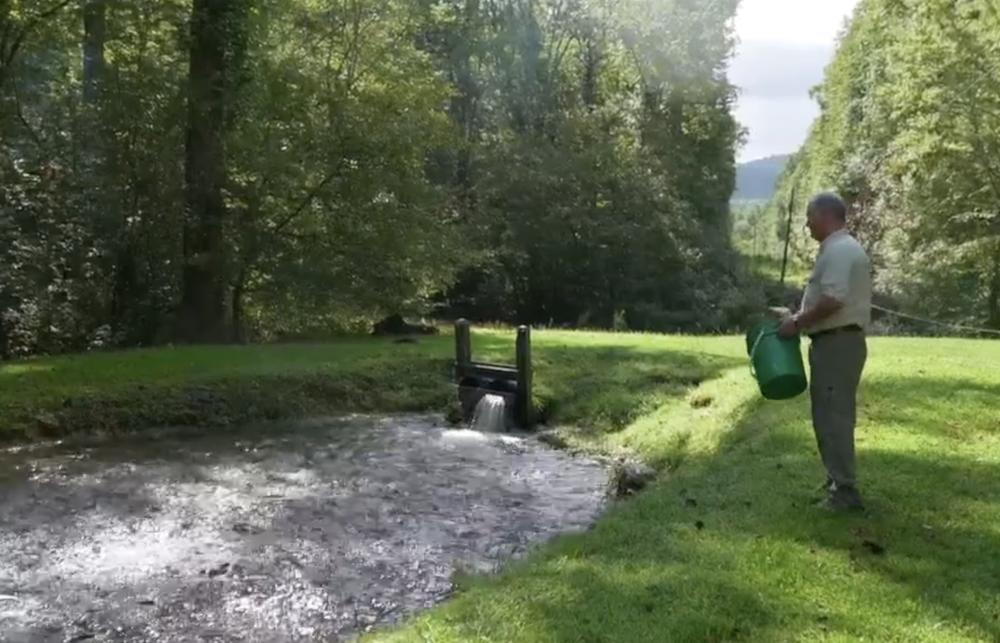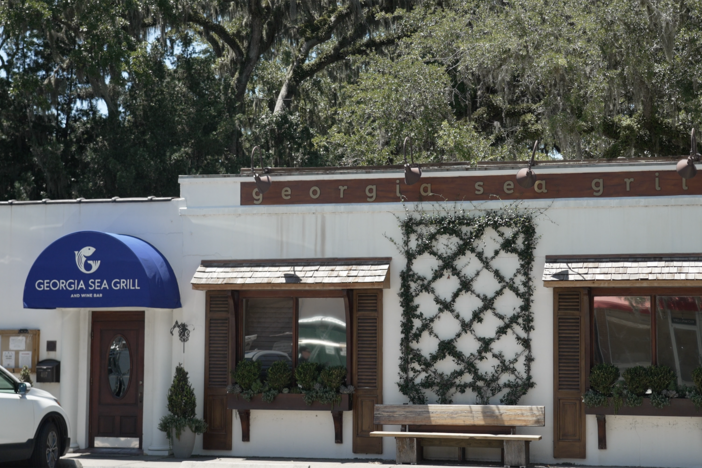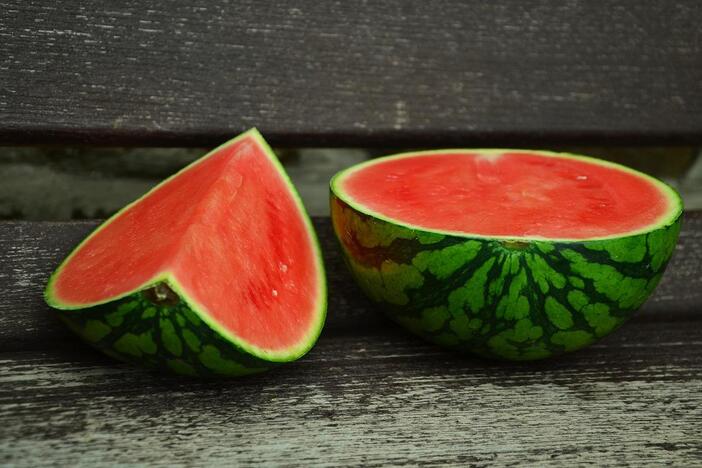
Section Branding
Header Content
A Fork in the Road Podcast: Bramlett Trout Farms
Primary Content
80 miles north of Atlanta is where you will find the community of Suches, Ga., the Valley Above the Clouds. It's known for its scenic views and abundant outdoor activities. Suches is home to the smallest public school in the state, the unofficial gateway to the Appalachian Mountains, and Bramlett Trout Farms.

TRANSCRIPT:
Terry Bramlett: We could harvest these fish and have them to the kitchens in the Atlanta restaurants in three hours. It takes us a year to produce a 1-pound trout, 16 ounces. That's with good growing conditions. The largest fish that we produced here weighed 26 and a half pounds.
David Zelski: Today, we're taking a trip 80 miles north of Atlanta to Union County, where we will visit the community of Suches, Ga. The Valley Above the Clouds is known for its scenic views and abundant outdoor activities. Suches is home to the smallest public school in the state and the unofficial gateway to the Appalachian Mountains, Woody Gap. As we travel, the curvy roads about a mile from Highway 60 is where we'll find Bramlett Trout Farms.
Theme Song: I came from the mud, there's dirt on my hands. Strong like a tree, there's roots where I stand.
David Zelski: I'm David Zelski, and this is the Fork in the Road podcast, featuring the stories from Georgia's farmers, fishermen, merchants, artisans, chefs and others who help provide Georgia-grown products to folks in the Peach State and beyond. Today, we're going to talk with Terry Bramlett. He's the owner of Bramlett Trout Farms.
Terry Bramlett: This land has been in my family for generations. I have great, great, great grandparents buried here, and we were thrilled to get to come back here and earn a living raising trout. We've been raising trout for 40 years now. Started in 1980. We've raised our family here. It's a wonderful place to live.
David Zelski: And what makes it such a wonderful place? Simply put, it's the water.
Terry Bramlett: Blessed to have the quality of water that we have here — able to acquire the land up the valley to secure the watershed. And that is one of the contributing factors to the quality of the trout that we raise here.
David Zelski: When you think about farming, you think about long hours of hard work, day in and day out. But trout are fish. So is owning a trout farm much more simple, like owning a big fish tank?
Terry Bramlett: Well, we just sit on the porch and watch them grow. Obviously, I'm kidding, it is labor intensive. We use certified disease-free eggs. Again, I mentioned we control the watersheds, so the water is as pure as it gets. We have input into the feed that they eat, so we know what they're eating. It's an incredibly pure product because there's no room for pollution anywhere along the line. We can harvest these fish and have them to the kitchens in the Atlanta restaurants in three hours.
David Zelski: There are a lot of places where you can find trout from Bramlett Trout Farms, and we will go over some of those places coming up later in the podcast. But we can't get ahead of ourselves. First, we need to know more about the process.
Terry Bramlett: The process, again, begins with the hatching of the eggs. Very labor intensive process. When those eggs hatch and use up the yolk sac, we feed them virtually every hour during daylight to get them started eating.
David Zelski: Now, feeding every hour sounds a little excessive, right? But it can actually be tough to get trout to start eating.
Terry Bramlett: They are a bit finicky when they're — when they first start up. And and if you don't get that initial feeding in them, then sometimes they may not survive. So we're very cautious about providing a very small amount of feed for them throughout the day so that they get started. Once they get started, they get very enthusiastic about eating. But that process, the hatching process and the swim up takes about a month. They remain in the hatchery for another month or month and a half. Then they're large enough to move outdoors into the earthen raceways. Takes us a year to produce a 1-pound trout, 16 ounces. That's with good growing conditions. If we can keep the fish in the second year, then we could grow up to 3 pounds. And then of course, we keep some fish up to trophy size for stocking purposes for some of our fly fishing customers.
David Zelski: Okay, let's add fly fishing for trophy-sized trout to the list of things we'll cover a little bit later in the podcast. For now, there's more to learn about the process of raising fish and why some of them need to be separated.
Terry Bramlett: We have to go through and separate the large fish from a hatch because there's nothing a trout would rather eat than a smaller trout. And once they get started, they become super fish, or that's what we call it. But we have to go through and grade those out and separate them from the rest of the population because they'll continue to eat those fish. And the first thing you know, you've got a handful of large fish and all of your small fish are gone. But that — that's part of the process. We call them super fish, and we have various means of grading them out, some by hand and some through a mechanical grader. But periodically we have to go through and separate those more aggressive, larger fish and they'll go into a group of fish more matched to their size so they don't eat the rest of the small ones. Once they get up about 4 inches long, 4 or 5 inches long, they'll — they're perfectly capable of fending for themselves outdoors, and that's the appropriate time to move them out and start the major growth period.
David Zelski: When they're ready to move outdoors, the fish just get tossed in the pond, right? No, of course not. There's a lot of science involved in setting up the right environment for the trout.
Terry Bramlett: Well, the basis is an earthen system. It's very natural. The fish don't brush up against those concrete walls, so it's not abrasive. And they have great fins, full fins and nice color from the minerals in the soil and the stones. Again, a very natural environment. The raceways were designed so that the water would completely turn over in about 14 to 16 minutes. The key to trout production is dissolved oxygen content of the water. So the water flows through us much like a stream. And of course we pour it, break it up to replenish the dissolved oxygen, and then we use it again. We have a series of those and we put it back into the stream bed and we pick it up again and do the same thing on three different courses. The colder the water is, the more dissolved oxygen it will hold molecularly. The opposite is true for warmer water, so we have to be very careful in those periods of time where we get extreme temperature changes. Typically in the mountains, it's very cool in the mornings, but in the afternoons we can get up to where the temperatures are challenging. So we have to control the feeding during those periods so the fish don't overeat in the morning and then become stressed in the afternoon. Trout are susceptible to stress-induced illness. So managing stress factors is part of what we do. We are, as-as all farmers are, we're subject to weather. We've had incredible rainfall this year. Regular rain almost on a weekly basis, almost. And again, we're dependent on that water flow for our — our — our trout operation.
David Zelski: If you remember earlier, Terry mentioned that some of the fish grow to be really big.
Terry Bramlett: Well, we have some customers that want trophy-sized trout. I grew up fly fishing for trout and I never caught anything that even approaches what we're raising here now. But the largest fish that — that we produced here weighed 26 and a half pounds. That's unheard of for rainbow trout in this part of the country. But we do enjoy watching those huge trout feed. And — and I've never tired of, of getting to handle them and see them in a safe fashion. Our restaurant business, very size specific: We'll have orders for 16-ounce, 18-ounce, 20-ounce, 22-ounce, 24-ounce fish on a weekly basis. So we hatch those eggs regularly every two months. We have a constant supply of trout coming along to fill those orders. They won't stay 16 ounces for very long. If you're feeding them, they're constantly growing. So that two-month window gives us an opportunity to fulfill those those orders and size specifications. A 16-ounce fish, a 1-pound live weight, is a very common single serving. Of course, we have some restaurants that want larger fish and they portion those filets so that they're exact and they have great success with those.
David Zelski: Some of those restaurants are Bacchanalia. Empire State South, Holman & Finch, Kimble House, and Tiny Lou's. Plus, fresh Bramlett Trout are available at Haywood Provisions in Roswell, Atlanta Highway Seafood in Gainesville, and Aventine in Rome. You might like your trout fried or baked or grilled. You can have it with garlic and lemon, smoked, pan seared, or herb roasted. All this talk is making me hungry.
Kitchen worker: Order up.
David Zelski: All right, back to the fish that grow really big. Can we make the trip to Bramlett Trout Farms and maybe do some fly fishing ourselves?
Terry Bramlett: Well, we can refer you to customers that do that, but we do not offer fishing here. First of all, we don't want to compete with our customers. Secondly, we've been very concerned over the years about the possibility of introducing a virus or any type of disease organism. So we're pretty restrictive about who we allow in and what we allow in. Some of the viruses that affect trout can live on a dry surface for three days. So on a fly or something that's a bit moist, there's a slight possibility that they could bring something in and it's just not worth the risk for us, for our operation.
David Zelski: I told you there's a lot of science involved in trout farming and Terry's journey to becoming the expert he is today started a long time ago with his love of fishing.
Terry Bramlett: Well, I can't really talk much about that because people make fun of me. Say "You've been raising trout for 40 years, and what do you do on a day off? You go fly fishing for trout." But that's one of the reasons we do what we do. When I was a teenager, if I wasn't working on weekends, my dad and I loved to fly fish for trout. So this is not just work. It's play for me. I spent yesterday morning with a dear friend on the Noontootla stream nearby, and we had a great morning fly fishing. And and in fact, I got to play some of those trophy-sized trout just before they spit my fly out and saluted me about 40 yards downstream. But it is still fun and I still enjoy fishing.
David Zelski: Now, Terry doesn't work the trout farm all by himself. His wife, Ruth, is by his side every day.
Terry Bramlett: We work together well, and we always have. We enjoy our time together. And she does everything on the farm that I do. She kind of draws the line on the live haul. She doesn't like the water moving around in the tank in the back of the truck. But oh, yes, it's been it's been a a great career and healthy place to raise our children.
David Zelski: Will Ruth and Terry retire soon and maybe pass the farm along to their children? Probably not.
Terry Bramlett: (laughing) The succession plan's not looking so good. Our daughters are clinical pharmacists and our son's an attorney, so they don't have a lot of interest in in running the trout hatchery. But nevertheless, it's been great for us.
David Zelski: You can find Ruth and Terry at Bramlett Trout Farms on Rainbow Road in Suches, Ga. And you can watch a Fork In The Road on GPB-TV or any time on the GPB.org website. That's where you'll also be able to listen and subscribe to this podcast or download it on your favorite podcast platform. I'm David Zelski. Thanks for listening to A Fork in the Road.
_____
The A Fork in the Road TV show airs Saturdays at noon and Sundays at 6:30 a.m. on GPB-TV. Check your local listings for other replays throughout the week and watch all episodes anytime at GPB.org/ForkintheRoad. Please download and subscribe to the Fork in the Road podcast at GPB.org/ForkintheRoadpodcast or on your favorite podcast platform as well.
80 miles north of Atlanta is where you will find the community of Suches, Georgia, the Valley Above the Clouds. It's known for its scenic views and abundant outdoor activities. Suches is home to the smallest public school in the state, the unofficial gateway to the Appalachian Mountains, and Bramlett Trout Farms.





